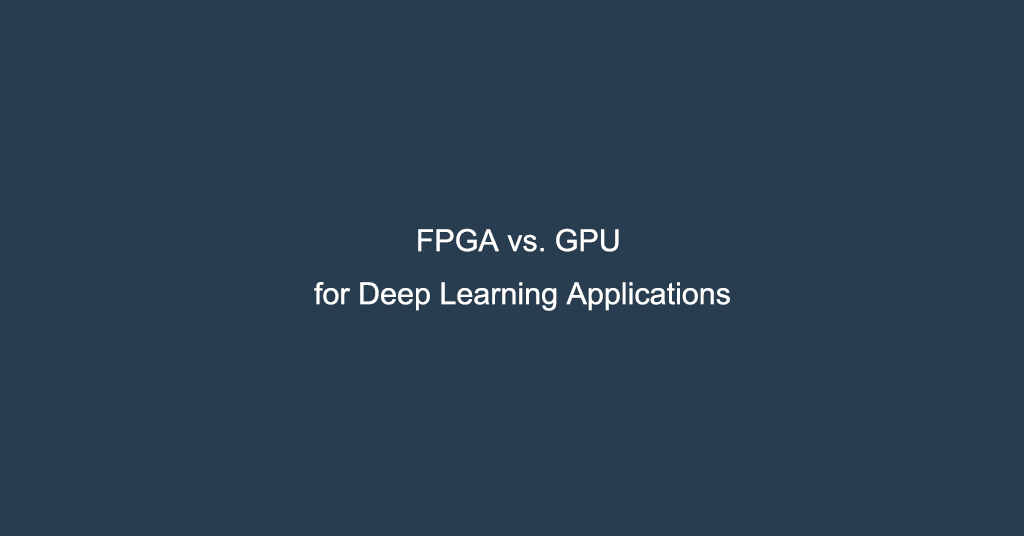FPGA VS GPU for Deep Learning Applications

With the rapid development of artificial intelligence (AI), new neural network models, techniques and use cases are constantly emerging. While there is no single chip architecture that fits all machine and deep learning applications, there are some use cases where we have found that FPGAs can have clear advantages over GPUs or other types of hardware.
1. What Is an FPGA?
FPGA (Field Programmable Gate Array), namely field programmable gate array, is the product of further development on the basis of programmable devices such as PAL, GAL, CPLD, etc. As a semi customized circuit in the field of application specific integrated circuit (ASIC), it not only solves the shortcomings of customized circuit, but also overcomes the shortcomings of the limited number of original programmable device gate circuits.
2. Why Choose an FPGA for Deep Learning?
Early artificial intelligence relies heavily on parallelism performance when running. Since GPUs are specifically designed to render video and graphics, it has become popular to use them for machine learning and deep learning.
GPUs are good at parallel computing processing and can perform a large number of arithmetic operations in parallel. In other words, it is much more computationally efficient than a CPU when it has to perform the same amount of work multiple times in a row.
However, running AI on GPUs has its limitations. Because GPUs do not perform as well as ASICs, ASICs are chips built specifically for a given deep learning workload.
FPGAs can provide hardware customization for integrated AI, with the ability to write specific programs to provide parallel computing behavior similar to GPUs or ASICs. The reprogrammable, reconfigurable nature of FPGAs is well suited to the rapidly evolving AI environment, allowing designers to quickly test algorithms and speed time-to-market.
3. Advantages of FPGAs in Deep Learning
A. Outstanding performance with high-speed computing and low latency
The FPGA provides low latency and deterministic latency for real-time applications such as video streaming, transcription, and actions such as motion recognition by bypassing the CPU and receiving video directly to the FPGA. Designers can build a neural network from scratch and construct an FPGA that best fits the model.
B. Super high cost performance
FPGAs can be reprogrammed for different functions and data types, making them one of the most cost-effective hardware options available. Furthermore, FPGAs can be used for more than just artificial intelligence. By integrating additional functionality onto the same chip, designers can save cost and board space.
FPGAs have a long product life cycle, so FPGA-based hardware designs can have a long product life, measured in years or decades. This feature makes it ideal for use in the industrial defense, medical and automotive markets.
C. Lower power consumption
Designers can fine-tune the hardware to meet energy efficiency requirements based on the application. FPGAs can accommodate a variety of functions, allowing the chip to provide greater energy efficiency. Instead of the entire chip, a portion of the FPGA’s overall computing power can be used for the corresponding function, allowing the FPGA to host multiple functions in parallel.
4. AI and Deep Learning Applications on FPGAs
When applications require low latency, FPGAs can provide performance advantages over GPUs in speech recognition and other natural language processing workloads. Due to its programmable I/O interface and highly flexible structure, FPGAs are also well suited for the following tasks
A. Overcome I/O bottlenecks.
FPGAs are typically used in situations where data must traverse many different networks with low latency. They are very useful in eliminating memory buffering and overcoming I/O bottlenecks, one of the most limiting factors in AI system performance. By accelerating data ingestion, FPGAs can accelerate the entire AI workflow.
B. Integrate AI into workloads.
Integrate AI into workloads. Using FPGAs, designers can add AI capabilities such as deep packet inspection or financial fraud detection to existing workloads.
C. Enable sensor fusion.
FPGAs excel at processing data input from multiple sensors such as cameras, lidar, and audio sensors. This capability is invaluable when designing autonomous vehicles, robots and industrial equipment.
D. Provides acceleration for high-performance computing (HPC) clusters.
FPGAs serve as programmable accelerators for inference, helping to facilitate AI and HPC convergence.
E. Add extra functionality beyond AI.
FPGAs can add security, I/O, networking, or pre/post-processing functions without requiring additional chips.
There are some hurdles to overcome when working with FPGAs, such as hardware that often requires specialized programming expertise. Many well-known chip brands are reducing the amount of expertise required for software-based programming models.
This high-level FPGA programming model allows data scientists or model developers to create neural networks using common AI frameworks such as TensorFlow or Caffe and deploy them on FPGAs without knowing the details of the FPGA architecture.
As AI applications grow, the range of applications and environments it runs will become extremely diverse, from end devices to edge servers to data centers. No single architecture, chip or form factor can meet the requirements of all AI applications. Infrastructure architects must have access to the architecture of their choice.
There are currently four main categories of chips that can support AI and deep learning in the mainstream market: FPGAs, GPUs, and ASICs for acceleration, and CPUs for general-purpose computing. Each architecture addresses unique needs, so infrastructure architects can choose the exact architecture needed to support any AI application. With a wide range of computing types, optimized for functionality and performance, they always get the right tool for the job at hand.
Haoxinshengic is a pprofessional FPGA and IC chip supplier in China. We have more than 15 years in this field。 If you need chips or other electronic components and other products, please contact us in time. We have an ultra-high cost performance spot chip supply and look forward to cooperating with you.
